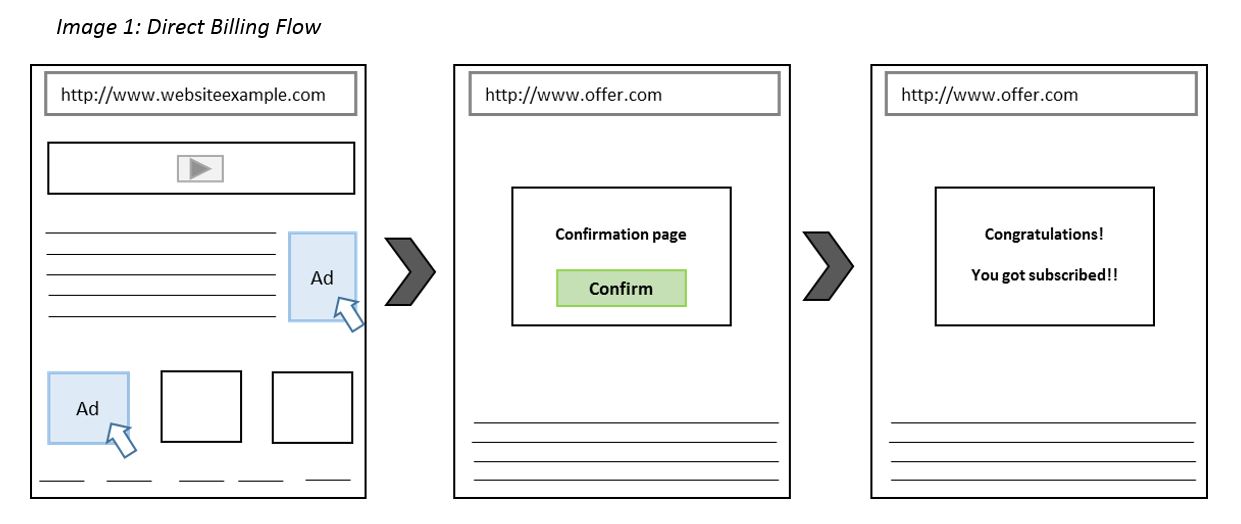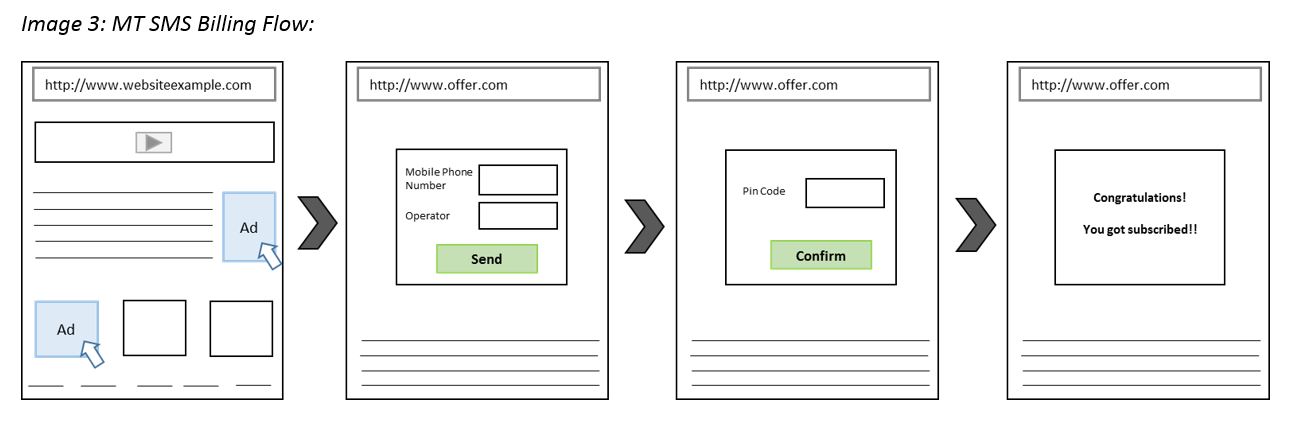Not every offer or landing page has the same performance. This is due to the fact that the offers are designed through different flows, and it always depends on the country, the operator’ requirements, the internet connection or the market niche. This means that even for the same country, the conversion rate can vary from one offer to another. In this article we will describe the most popular offers’ flow you can find when a user is navigating on Mobile Internet and how it can impact the campaign performance.
When the user is navigating within a website on the Internet, he usually finds bannerads strategically displayed in some spots on the website. Whether it considers the banner interesting or it didn’t find the information it was looking for on the website, the user clicks on the banner ad. After this step, the offer displayed to the user can change according to the billing option activated.
DIRECT BILLING FLOW:
Some carriers are able to identify automatically the MSISDN (the mobile number which identifies the mobile user), and the billing is made directly meaning that the money is taken directly from his cellphone balance. This flow is usually associated with the 3G connection, but it is always determined by the billing system of the carrier.

Another important factor that affects the performance of a direct billing campaign is the type of opt-in the operator requires:
SMS BILLING FLOW:
For this flow, the user needs to send or insert its mobile phone number in order for the carrier system to identify the MSISDN, as it is not recognized automatically. This flow is commonly associated with the Wi-Fi connection.
In the SMS billing flow, some operators require the user to send a message to a specific number (MO) or to receive a pin code by SMS that then the user has to insert on the landing page (MT).
This type of flow is usually associated with one-shot offers, where the user is charged only at the moment it sends the SMS.
For some advertisers and/or devices, besides appearing the message on the landing page with all the information needed, it can open the SMS box of the mobile phone of the user, with the keyword and LA already filled. This is called the Click-to-SMS flow, where the conversion rate is much higher than the traditional MO flow.


These two flows described above will have different performances on the campaigns. While the direct billing flow only requires a confirmation to the service, the SMS billing flow implies the user to insert its personal information or sends an SMS message. As it is more obvious to the user that it will be charged, the conversion rate for SMS billing is much lower than for the direct billing flow.
The payment for a conversion can also varies from CPA or CPI. CPA is used for subscription services and it means the cost by an acquisition, action or conversion, while the CPI is the payout for each app’ installation.
CREDIT CARD BILLING:
For some mobile offers, namely dating products, the billing option is usually made by credit card, which means that the user needs to insert its credit card information in order to create its profile. Some dating offers are based on subscription services, where the payment is by CPA and the user gets access to private chats.
For this flow, the payout of an offer usually varies from CPL to CPS. CPL or PPL is the cost per lead, where the payment is made as soon as the profile is created on the offer. The CPS or PPS stands for cost per sale and it occurs when the user is effectively charged by the service.
For CPS campaigns, the conversion rate will be lower and the payout normally higher, as the user cannot be willing to introduce its personal data like the credit card information as well as it is clearer that the user will be charged.
FINAL NOTES:
In fact, there are a lot of possible combinations for an offer flow. If the conversion process is shorter, the conversion rate of a campaign will be higher. The same is true for the opposite, which means that for conversion submissions that are too long, the conversion rate will be lower. That’s why you can promote an offer for the same vertical and for the same country with performances completely different. That’s why you find payouts so different in the same country for different operators/carriers. And all these elements you cannot control, you only can be aware of them and manage your campaigns accordingly.
When the user is navigating within a website on the Internet, he usually finds bannerads strategically displayed in some spots on the website. Whether it considers the banner interesting or it didn’t find the information it was looking for on the website, the user clicks on the banner ad. After this step, the offer displayed to the user can change according to the billing option activated.
DIRECT BILLING FLOW:
Some carriers are able to identify automatically the MSISDN (the mobile number which identifies the mobile user), and the billing is made directly meaning that the money is taken directly from his cellphone balance. This flow is usually associated with the 3G connection, but it is always determined by the billing system of the carrier.

Another important factor that affects the performance of a direct billing campaign is the type of opt-in the operator requires:
- Single Opt-in:
- Double Opt-in:
SMS BILLING FLOW:
For this flow, the user needs to send or insert its mobile phone number in order for the carrier system to identify the MSISDN, as it is not recognized automatically. This flow is commonly associated with the Wi-Fi connection.
In the SMS billing flow, some operators require the user to send a message to a specific number (MO) or to receive a pin code by SMS that then the user has to insert on the landing page (MT).
- Mobile Originated (MO):
This type of flow is usually associated with one-shot offers, where the user is charged only at the moment it sends the SMS.
For some advertisers and/or devices, besides appearing the message on the landing page with all the information needed, it can open the SMS box of the mobile phone of the user, with the keyword and LA already filled. This is called the Click-to-SMS flow, where the conversion rate is much higher than the traditional MO flow.

- Mobile Terminated (MT):

These two flows described above will have different performances on the campaigns. While the direct billing flow only requires a confirmation to the service, the SMS billing flow implies the user to insert its personal information or sends an SMS message. As it is more obvious to the user that it will be charged, the conversion rate for SMS billing is much lower than for the direct billing flow.
The payment for a conversion can also varies from CPA or CPI. CPA is used for subscription services and it means the cost by an acquisition, action or conversion, while the CPI is the payout for each app’ installation.
CREDIT CARD BILLING:
For some mobile offers, namely dating products, the billing option is usually made by credit card, which means that the user needs to insert its credit card information in order to create its profile. Some dating offers are based on subscription services, where the payment is by CPA and the user gets access to private chats.
For this flow, the payout of an offer usually varies from CPL to CPS. CPL or PPL is the cost per lead, where the payment is made as soon as the profile is created on the offer. The CPS or PPS stands for cost per sale and it occurs when the user is effectively charged by the service.
For CPS campaigns, the conversion rate will be lower and the payout normally higher, as the user cannot be willing to introduce its personal data like the credit card information as well as it is clearer that the user will be charged.
FINAL NOTES:
In fact, there are a lot of possible combinations for an offer flow. If the conversion process is shorter, the conversion rate of a campaign will be higher. The same is true for the opposite, which means that for conversion submissions that are too long, the conversion rate will be lower. That’s why you can promote an offer for the same vertical and for the same country with performances completely different. That’s why you find payouts so different in the same country for different operators/carriers. And all these elements you cannot control, you only can be aware of them and manage your campaigns accordingly.





